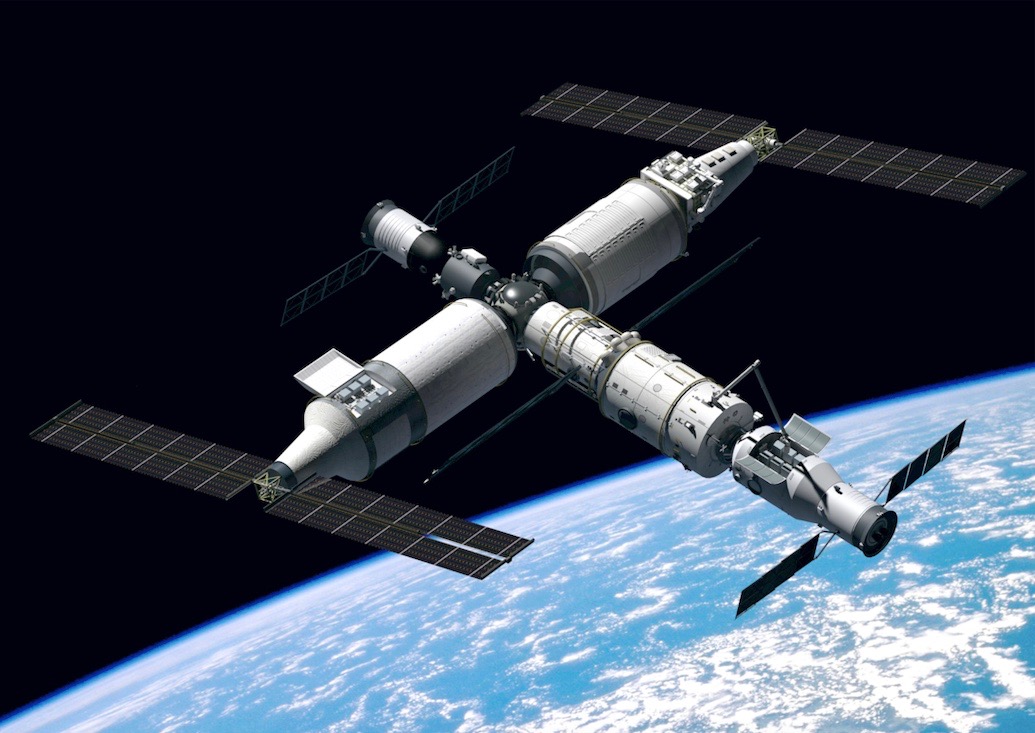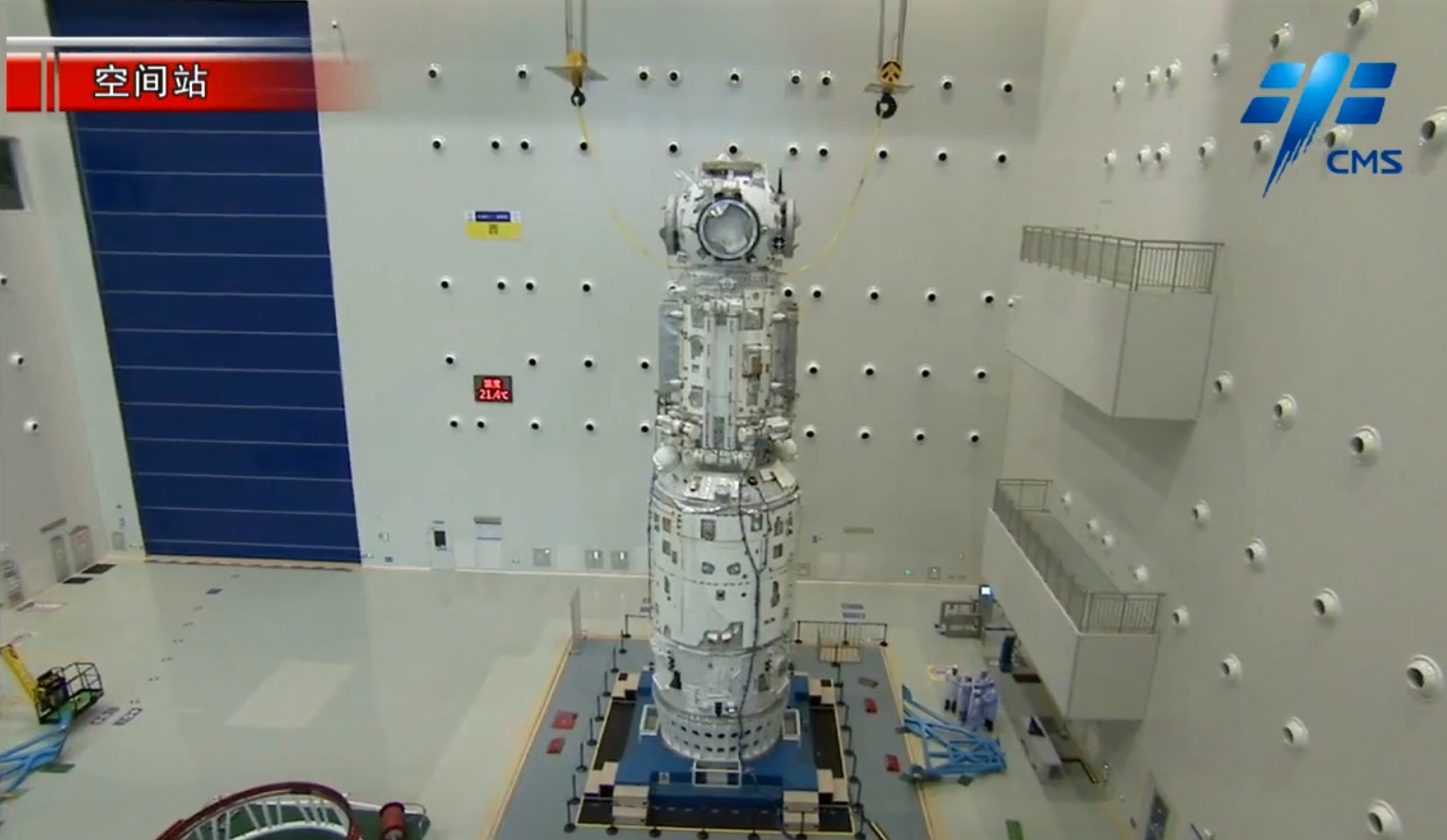
China's new space station will need 10 more launches to complete
China will be busy for the next year and a half.

China's core space station module is now circling Earth.
The module, called Tianhe ("Harmony of the Heavens"), launched Wednesday night (April 28) atop a Long March-5B Y2 carrier rocket from the Wenchang Spacecraft Launch Site on the northeastern coast of south China's Hainan Province.
Tianhe is the foundational module for China's first space station. The module is billed as the largest spacecraft the nation has ever developed; it's 54.4 feet (16.6 meters) long, 13.8 feet (4.2 m) across at its widest point, and had a mass at liftoff of 22.5 tons.
Related: The latest news about China's space program
Fast-paced launch schedule
Wednesday's launch will be followed by a fast-paced series of cargo and crew launches aimed at completing the construction of the space station by the end of 2022.
The space-based construction effort requires 10 additional launches from 2021 through 2022: two more module launches, four crewed missions and four cargo vessel flights, as reported by China Global Television Network (CGTN).
Three types of Long March carrier rockets will jointly launch the remaining 10 missions.
Get the Space.com Newsletter
Breaking space news, the latest updates on rocket launches, skywatching events and more!
When completed, China's orbiting outpost will form a T-shape with Tianhe at the center and two other modules, Wentian and Mengtian, on each side, according to Zhou Jianping, chief designer of China's crewed space program.
Bai Linhou, deputy chief designer of the space station at the China Academy of Space Technology (CAST), said that the station could support at most six astronauts at the same time. Regular launches of crewed and cargo spaceships will secure a long-term human presence in Earth orbit to carry out research and services, Chinese officials have said.
Related: China selects 18 new astronauts in preparation for space station launch

Crew and cargo
Shortly after the core module's launch, Li Shangfu, chief commander of flight missions for the space station phase of China's crewed space program, reported the Long March-5B Y2 rocket had accurately sent Tianhe into a preset orbit, and that the module's solar panels were working well after unfolding. "Now I announce that the launch mission of the core module Tianhe is a complete success!" Li said.
Hao Chun, director of the China Manned Space Engineering Office, told China Central Television (CCTV): "Next, we will launch Tianzhou 2 cargo spacecraft in May and the Shenzhou 12 spacecraft in June. Three astronauts will stay in orbit for three months on the Shenzhou 12 manned spacecraft."
Hao said that the Tianzhou 3 cargo craft will launch toward Tianhe this September and the Shenzhou 13 crewed spaceship will follow in October. Shenzhou 13 will carry three astronauts, who will stay on Tianhe for six months.
China plans to launch six more station-building missions in 2022. These will loft the Wentian and Mengtian lab modules, two cargo spacecraft and two crewed spaceships, completing the assembly of the orbiting outpost.
"The two manned spacecraft, also composed of three astronauts respectively, will stay in orbit for about six months," Hao said, referring to the 2022 crewed flights. "This is the general arrangement of our missions."
China's space station is to operate in low Earth orbit at an altitude from 211 miles (340 kilometers) to 280 miles (450 km). It has a designed lifespan of 10 years, although it could last more than 15 years with appropriate maintenance and repairs, CCTV reported.
You can view video of the Tianhe launch and get an overview of China's space station plans here, here and here.
Leonard David is author of "Moon Rush: The New Space Race," which was published by National Geographic in May 2019. A longtime writer for Space.com, David has been reporting on the space industry for more than five decades. Follow us on Twitter @Spacedotcom and on Facebook.
Join our Space Forums to keep talking space on the latest missions, night sky and more! And if you have a news tip, correction or comment, let us know at: community@space.com.

Leonard David is an award-winning space journalist who has been reporting on space activities for more than 50 years. Currently writing as Space.com's Space Insider Columnist among his other projects, Leonard has authored numerous books on space exploration, Mars missions and more, with his latest being "Moon Rush: The New Space Race" published in 2019 by National Geographic. He also wrote "Mars: Our Future on the Red Planet" released in 2016 by National Geographic. Leonard has served as a correspondent for SpaceNews, Scientific American and Aerospace America for the AIAA. He has received many awards, including the first Ordway Award for Sustained Excellence in Spaceflight History in 2015 at the AAS Wernher von Braun Memorial Symposium. You can find out Leonard's latest project at his website and on Twitter.









